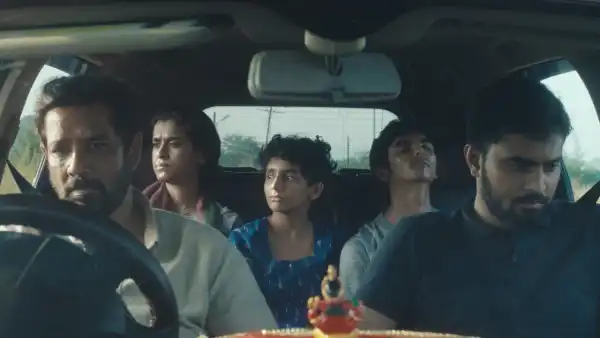
Save this storySave this storySave this storySave this story
View “Holy Curse.”
“Holy Curse,” a recent short film by Snigdha Kapoor, an Indian filmmaker residing in the U.S., includes a couple of scenes depicting urination at the side of the road. “I’ve done it countless times,” Kapoor mentioned to me, chuckling, during a Zoom conversation from her Jersey City residence. In the movie, one offender is Radha, an androgynous adolescent grappling with the gender specifications of early adolescence. Radha and their parents, who reside in the States, are visiting family in India, and the adults perceive Radha’s unconventional gender identity as an age-old “curse” that requires a ceremonial exorcism. The film’s aesthetic approach—characterized by confined framing, intimate handheld shots, and abrupt transitions—mirrors Radha’s unease.
In a more straightforward narrative, the uncle who organizes a religious rite to purify Radha would be the antagonist. However, Kapoor’s allegory acknowledges that restrictive cultural conventions can be implemented even by individuals with good intentions. The character was modeled after her paternal grandfather, who held a comparable position during her own youth. “I grew up believing I was a boy,” Kapoor, now thirty-seven years old, revealed. In India, during the nineties, she engaged in sports alongside boys and emulated their mannerisms and style. Her father affectionately addressed her as beta, or “son.” “When my body began to transform, my grandfather would remark, ‘You can’t speak like that,’ ‘You can’t sit like that,’ ‘You are a girl.’ I didn’t grasp the significance of that.” The monitoring arose, in part, from a sense of apprehension: in Ghaziabad, where Kapoor was brought up, personal expression was a severe concern. “People were murdered in plain sight,” she stated. “It was a delicate balance of, ‘How do you articulate your opinion without getting killed?’ ”
Kapoor commenced her career in documentary filmmaking—and, upon relocating to New York nearly thirteen years prior to serve as a cinematographer, she became disillusioned with the limited range of narratives she was helping to convey. There was a lack of intricate representations of the South Asian diaspora. As a result, she explained, “I essentially taught myself how to write.” In 2023, she went back to India to create “Holy Curse,” which led to unexpected political issues: following months of searching, the crew had only gotten two audition videos for the part of Radha. Kapoor remembered parents informing her that they were impressed with the script but that “we don’t want our daughters subjected to these themes.” Just days before they were set to begin filming, she discovered her lead: the intelligent Mrunal Kashid, who brought to mind her younger counterpart.
For Kapoor, the U.S. perspective on these matters presented a distinct array of hurdles. “When I came to the States, I received this glossary of terms and language that would aid me in comprehending my identity,” she shared with me. “But simultaneously, it felt quite constricting.” She continued, “If I commit to a specific term, then I attempt to demonstrate what I believe corresponds to that term.” Keeping this in mind, she resolved to never specify Radha’s experience. Onscreen, it exists as it is––a compilation of understandings, independent of nomenclature. While Kapoor recognizes that Radha is inherently nonbinary, she also desired to allow them space to evolve: “I’m uncertain of how they’ll feel in a decade.”
Sourse: newyorker.com






